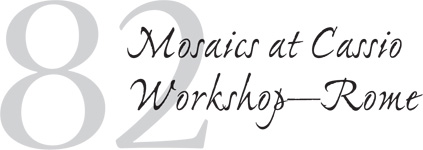

I’M WEARING GOGGLES, AND HAVE A SHARP HAMMER poised in one hand, while the other steadies a small piece of white stone on a metal pedestal. I’m setting it up just right to strike and split the stone.
My teacher Uliana just demonstrated what looked like a simple move. She did it a few times, perfectly creating tiny tiles, what the Romans named tesserae, that are used to make mosaics. Now it’s my turn to try. I feel the gut-clenching I’m going to smash my thumb fear, as I lower down the hammer. Doh! My move just chips the stone instead of splitting it. “Try again,” Uliana says, smiling. More vain attempts follow until, miraculously, I hit with just the right stroke and force, and the stone cleanly breaks in two. It’s a ta-da moment.
I’m feeling my way through this morning mosaic-making class at Studio Cassio, in Rome’s Monti Rione. This area, between the Colosseum and Santa Maria Maggiore Basilica, is a working-class-turning-trendy neighborhood, with vintage stores, artisan workshops, and the lovely Piazza della Madonna Monti, where mammas hang out by the fountain with their baby strollers. Narrow cobblestoned vias flanked by ivy covered stone buildings create such a perfect atmosphere that Woody Allen chose it to film scenes from To Rome With Love.
The mosaics studio is run by the Cassio family, master mosaic artisans in Rome for three generations. It began a hundred years ago with Lorenzo, who directed the Vatican Mosaic Studio. Uliana tells me that Lorenzo was so passionate about the work, that he required his eight children to complete one mosaic every day while they were growing up.
Lorenzo’s son Antonio founded this Monti workshop in 1945, and the business flourished as he and his crew decorated and restored hundreds of Rome’s churches, private villas, and monumental sites such as Pompeii and the Baths of Caracalla. They also expanded their work to international projects, including the circular “Imagine” mosaic that’s the centerpiece of John Lennon’s memorial in Central Park, a place I visit on every trip to New York. It’s a thrill to look through a photo album that Uliana pulls out, seeing Antonio in the 1980s standing over a circular patch of dirt in the park, and the mosaic being installed step-by-step.
I choose a decorative swirly pattern and with black and white tesserae begin my work with tweezer-like-tools, putting together the small puzzle with the stones I’d split. At the next table is a much more experienced signora, working on an intricate portrait of Pope Francis, with richly colored tessarae, as Uliana leans over, coaching her along.
It’s about following lines, paying close attention to the subtle difference in the stones’ shapes to choose which will make the best fit for the design. There are stones all around me—overflowing out of drawers and cloth bags and on my work table. Uliana tells me that restoration work was once done by bringing the pieces that were to be repaired to this studio, but now by law the restoration has to be done on site, using pieces of the original. The stones I’m using are from the stash left over from the old days—2,000-year-old pieces that were part of mosaics in Pompeii or the Vatican.
As my swirl begins to take shape, I’m imagining the crews that worked hundreds of years ago, decorating the Rome church interiors I love—the dazzling Santa Maria in Trastevere, circular patterned floors of Santa Maria in Cosmedin. My hands move as theirs did, breaking stones apart to carefully put them in a new order. There’s a profound satisfaction in doing this tesserae by tesserae until the design emerges.
No thumbs were smashed during the making of my mosaic. Uliana boxes it up and I tuck it into my purse. I head out, enlightened, seeing every mosaic from this workshop on with a new appreciation of all those hands of the past, who broke stones to put them together and create awe-inspiring beauty.
Studio Cassio: Via Urbana, 98-98a, studiocassio.com
Courses range from half day (2.5 hours) to three-day immersions, with options to follow ancient patterns or make self-portraits, or to learn the art of micro-mosaic jewelry making.